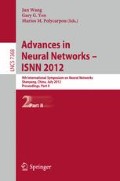Abstract
Sparse representation method, especially the Two-Phase Test Sample Representation (TPTSR) method is regarded as a powerful algorithm for face recognition. The TPTSR method is a two-phase process in which finds out the M nearest neighbors to the testing sample in the first phase, and classifies the testing sample into the class with the most representative linear combination in the second phase. However, this method is limited by the overwhelming computational load, especially for a large training set and big number of classes. This paper studies different nearest neighbor selection approaches for the first phase of TPTSR in order to reduce the computational expenses of face recognition. Experimental results and theoretical analysis show that computational efficiency can be significantly increased by using relatively more straightforward criterions while maintaining a comparable classification performance with the original TPTSR method.
Access this chapter
Tax calculation will be finalised at checkout
Purchases are for personal use only
Preview
Unable to display preview. Download preview PDF.
References
Kirby, M., Sirovich, L.: Application of the KL phase for the characterization of human faces. IEEE Trans. Pattern Anal. Mach. Intell. 12, 103–108 (1990)
Xu, Y., Zhang, D., Yang, J., Yang, J.-Y.: An approach for directly extracting features from matrix data and its application in face recognition. Neurocomputing 71, 1857–1865 (2008)
Yang, J., Zhang, D., Frangi, A.F., Yang, J.-Y.: Two-dimensional PCA: A new approach to appearance-based face representation and recognition. IEEE Trans. Pattern Anal. Mach. Intell. 26, 131–137 (2004)
Xu, Y., Zhang, D.: Represent and fuse bimodal biometric images at the feature level: Complex-matrix-based fusion scheme. Opt. Eng. 49 (2010)
Park, S.W., Savvides, M.: A multifactor extension of linear discriminant analysis for face recognition under varying pose and illumination. EURASIP J. Adv. Signal Process. 2010, 11 (2010)
Debruyne, M., Verdonck, T.: Robust kernel principal component analysis and classification. Adv. Data Anal. Classification 4, 151–167 (2010)
Xu, Y., Zhang, D., Song, F., Yang, J.-Y., Jing, Z., Li, M.: A method for speeding up feature extraction based on KPCA. Neurocomputing 70, 1056–1061 (2007)
Tipping, M.E.: Sparse kernel principal component analysis. In: Leen, T.G.D.T.K., Tresp, V. (eds.) Neural Information Processing Systems, pp. 633–639. MIT Press, Cambridge (2000)
Schölkopf, B., Smola, A., Müller, K.-R.: Kernel Principal Component Analysis. In: Gerstner, W., Hasler, M., Germond, A., Nicoud, J.-D. (eds.) ICANN 1997. LNCS, vol. 1327, pp. 583–588. Springer, Heidelberg (1997)
Schölkopf, B., Smola, A.: Learning With Kernels. MIT Press, Cambridge (2002)
Muller, K.-R., Mika, S., Rätsch, G., Tsuda, K., Schölkopf, B.: An introduction to kernel-based learning algorithms. IEEE Trans. Neural Netw. 12, 181–201 (2001)
Tao, D., Tang, X.: Kernel full-space biased discriminant analysis. In: IEEE ICME, pp. 1287–1290 (June 2004)
Fan, Z., Xu, Y., Zhang, D.: Local Linear Discriminant Analysis Framework Using Sample Neighbors. IEEE Trans. Neu. Net. 22, 1119–1132 (2011)
Xu, Y., Zhang, D., Yang, J., Yang, J.-Y.: A two-phase test sample sparse representation method for use with face recognition. IEEE Trans. Cir. Sys. Vid. Tech. 21 (2011)
http://www.cl.cam.ac.uk/research/dtg/attarchive/facedatabase.html
Author information
Authors and Affiliations
Editor information
Editors and Affiliations
Rights and permissions
Copyright information
© 2012 Springer-Verlag Berlin Heidelberg
About this paper
Cite this paper
Ma, X., Wu, N. (2012). Two-Phase Test Sample Representation with Efficient M-Nearest Neighbor Selection in Face Recognition. In: Wang, J., Yen, G.G., Polycarpou, M.M. (eds) Advances in Neural Networks – ISNN 2012. ISNN 2012. Lecture Notes in Computer Science, vol 7368. Springer, Berlin, Heidelberg. https://doi.org/10.1007/978-3-642-31362-2_25
Download citation
DOI: https://doi.org/10.1007/978-3-642-31362-2_25
Publisher Name: Springer, Berlin, Heidelberg
Print ISBN: 978-3-642-31361-5
Online ISBN: 978-3-642-31362-2
eBook Packages: Computer ScienceComputer Science (R0)

